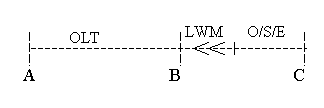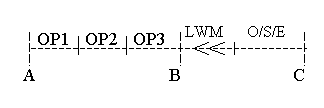Production lead-time calculation in Enterprise PlanningEnterprise Planning can determine lead times for planned production orders in two ways:
Which method LN uses, depends on the value that you specified in the Operations Time Fence field in the Items - Planning (cprpd1100m000) session. Usually, LN plans production order based on a routing, on a second-by-second basis. A fixed lead time is less detailed: it is expressed in working days, and is quantity-independent. On the other hand, using fixed lead times leads to faster calculations. For longer-term planning, the level of detail offered by routing-based planning is not always necessary. Especially in the following cases, a fixed lead time can be a useful approximation:
Fixed lead-time horizon In Enterprise Planning you can set a fixed lead-time horizon. In the Operations Time Fence field in the Items - Planning (cprpd1100m000) session, you can specify the number of workdays after which the fixed lead-time horizon starts. The value of this field is used in the following way:
Important! If the Operations Time Fence field is zero, you cannot transfer the generated planned orders to the execution level, because Enterprise Planning links no routing operations to the planned order. You can use this setting only for simulations. Note If the Operations Time Fence is greater than zero, Enterprise Planning rounds the start of the fixed lead-time horizon to the end of a plan period. As a result, the fixed lead-time horizon effectively starts at the next plan period. The start date of a planned order determines whether the order falls before or within the fixed lead-time horizon. If you apply backward planning, Enterprise Planning first carries out preliminary backward planning by using the fixed lead time. The resulting preliminary start date is checked against the fixed lead-time horizon. If this start date is before the fixed lead-time horizon, Enterprise Planning repeats the calculation with detailed routing data. Before Enterprise Planning actually plans the order lead time, it offsets the order finish date with the following lead-time components:
Lead-time planning with a fixed lead time If the order start date falls after the fixed lead-time horizon, the production order lead-time is always equal to the order lead-time in the Item - Production (tiipd0101m000) session. You can either enter a value in the Order Lead Time field of the Item - Production (tiipd0101m000) session, or let LN automatically fill in this field. In the latter case, you must run the Update Order Lead Times (tirou1202m000) session to let Enterprise Planning calculate the value. Enterprise Planning plans the fixed lead time based on the calendar of the item's enterprise unit. This planning process consists of the following steps:
Figure 1: Lead-time planning with a fixed lead time  Figure 1
Lead-time planning with detailed routing data If the order start date falls before the fixed lead-time horizon, Enterprise Planning uses detailed routing data to calculate the order lead-time, and, subsequently, use this order lead-time to compute the order start date. Enterprise Planning retrieves these routing data from the Routing module in Manufacturing. For each item, you can define a series of routings, and for each item/routing combination, you must define operations. Which routing LN selects depends, among other things, on:
After Enterprise Planning selects a routing, it can calculate the order lead-time, which consists of a series of separate operations lead-times. To calculate these operation lead-times, Enterprise Planning retrieves the following operation data from the Routing Operations (tirou1102m000) session: Enterprise Planning calculates operation lead-times with the following formula: Operation lead time = Queue time + Cycle time * quantity + Wait time + Move time Figure 2: Lead-time planning with detailed routing data  Figure 2
| |||||||||||||||||||||||||||